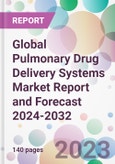The global pulmonary drug delivery systems market size was valued at USD 56.9 billion in 2023, driven by both technological advancements and changing healthcare needs across the globe. The market size is anticipated to grow at a CAGR of 5.6% during the forecast period of 2024-2032 to achieve a value of USD 93.3 billion by 2032.
Another notable shift is the exploration of the pulmonary route for the delivery of non-respiratory drugs, expanding the potential applications of these systems. The industry is also witnessing a surge in collaborations between pharmaceutical and tech companies, aiming to integrate digital technology into drug delivery for enhanced patient outcomes.
Moreover, with the global focus on reducing the invasiveness of treatments, pulmonary systems offer a promising non-invasive alternative, driving further interest and investment. In essence, the global pulmonary drug delivery systems market is on a trajectory marked by technological integration, expanded therapeutic applications, and a patient-centric approach, promising improved healthcare outcomes in the respiratory domain and beyond.
Furthermore, strategic collaborations between tech firms and pharmaceutical giants are fostering innovations that promise enhanced patient experiences and outcomes. Collectively, with its technological advancements, diverse therapeutic applications, and a focus on patient convenience, the global pulmonary drug delivery systems market is poised for sustained growth and evolution.
This product will be delivered within 5-7 business days.
Pulmonary Drug Delivery Systems: Introduction
Pulmonary drug delivery systems refer to methodologies and devices that administer medications directly into the lungs. The primary advantage of this mode of delivery is that it offers a direct route to the respiratory system, allowing for rapid and efficient absorption of drugs, especially those intended for local action within the lungs. Given the vast surface area and highly vascularized nature of the lungs, they serve as an excellent site for the absorption of therapeutics.Key Trends in the Global Pulmonary Drug Delivery Systems Market
The global pulmonary drug delivery systems market is undergoing transformative changes, driven by both technological advancements, and changing healthcare needs. A significant trend is the development of smart inhalers, equipped with sensors and connectivity features, allowing for better dose tracking, patient adherence, and data collection for personalized treatment. With the rising prevalence of respiratory diseases, especially in urban areas due to pollution and changing lifestyles, there's a heightened demand for advanced and efficient inhalation devices.Another notable shift is the exploration of the pulmonary route for the delivery of non-respiratory drugs, expanding the potential applications of these systems. The industry is also witnessing a surge in collaborations between pharmaceutical and tech companies, aiming to integrate digital technology into drug delivery for enhanced patient outcomes.
Moreover, with the global focus on reducing the invasiveness of treatments, pulmonary systems offer a promising non-invasive alternative, driving further interest and investment. In essence, the global pulmonary drug delivery systems market is on a trajectory marked by technological integration, expanded therapeutic applications, and a patient-centric approach, promising improved healthcare outcomes in the respiratory domain and beyond.
Global Pulmonary Drug Delivery Systems Market Segmentation
Market Breakup by Product Type
- Dry Powder Inhalers
- Metered Dose Inhalers
- Nebulizers
- Jet Nebulizers
- Soft Mist Nebulizers
- Ultrasonic Nebulizers
- Others
Market Breakup by Applications
- Cystic Fibrosis
- Asthma
- Allergic Rhinitis
- COPD
- Others
Market Breakup by End User
- Hospitals
- Diagnostic Centres
- Homecare Settings
- Others
Market Breakup by Region
- North America
- Europe
- Asia Pacific
- Latin America
- Middle East and Africa
Global Pulmonary Drug Delivery Systems Market Overview
The global pulmonary drug delivery systems market is experiencing a robust expansion, primarily driven by the escalating incidence of respiratory disorders such as asthma and COPD. As the need for effective and rapid treatment modalities grows, so does the demand for advanced inhalation devices like metered-dose inhalers, dry powder inhalers, and nebulizers. Modern technological integrations, including smart inhalers with digital adherence tracking features, are setting new standards in the industry. Beyond treating respiratory ailments, the potential of the pulmonary route for systemic drug delivery is being increasingly recognized, broadening the market's scope. Emerging markets, with their growing healthcare infrastructures and increasing awareness, are contributing significantly to the market's growth.Furthermore, strategic collaborations between tech firms and pharmaceutical giants are fostering innovations that promise enhanced patient experiences and outcomes. Collectively, with its technological advancements, diverse therapeutic applications, and a focus on patient convenience, the global pulmonary drug delivery systems market is poised for sustained growth and evolution.
Global Pulmonary Drug Delivery Systems Market: Competitor Landscape
The key features of the market report include patent analysis, grants analysis, clinical trials analysis, funding and investment analysis, partnerships, and collaborations analysis by the leading key players. The major companies in the market are as follows:- Koninklijke Philips NV
- GlaxoSmithKline PLC
- 3M
- Boehringer Ingelheim International GmbH
- AstraZeneca
- Cipla Inc.
- Merck & Co.
- GF Health Products Inc.
- Aerogen
- PARI GmbH
- Gilbert Technologies
This product will be delivered within 5-7 business days.
Table of Contents
1 Preface
3 Global Pulmonary Drug Delivery Systems Market Overview
4 Global Pulmonary Drug Delivery Systems Market Landscape
5 Global Pulmonary Drug Delivery Systems Market Dynamics
6 Global Pulmonary Drug Delivery Systems Market Segmentation
7 North America Pulmonary Drug Delivery Systems Market
8 Europe Pulmonary Drug Delivery Systems Market
9 Asia Pacific Pulmonary Drug Delivery Systems Market
10 Latin America Pulmonary Drug Delivery Systems Market
11 Middle East and Africa Pulmonary Drug Delivery Systems Market
12 Patent Analysis
13 Grants Analysis
14 Funding Analysis
15 Partnership and Collaborations Analysis
16 Regulatory Framework
17 Supplier Landscape
18 Global Pulmonary Drug Delivery Systems Market - Distribution Model (Additional Insight)
20 Company Competitiveness Analysis (Additional Insight)
21 Payment Methods (Additional Insight)
Companies Mentioned
- Koninklijke Philips NV
- GlaxoSmithKline PLC
- 3M
- Novartis AG
- Boehringer Ingelheim International GmbH
- AstraZeneca
- Cipla Inc.
- Merck & Co.
- GF Health Products Inc.
- Aerogen
- PARI GmbH
- Gilbert Technologies
Methodology

LOADING...








